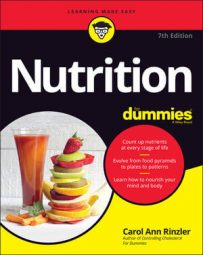You know that the mouth is where you put your food, but did you realize it was part of your digestive system? Well, it is. The act of chewing (the technical term for it is mastication) is the first step in digesting. Your body must break down food into smaller and smaller pieces so that the nutrients contained in the food can be released from the food and used by your body. After all, the true purpose of eating and digestion is to gain nutrients to keep your body functioning.
Mmmm. . . . Your mouth is a busy place
During mechanical digestion, the teeth start breaking down the food into smaller bits, but the rest of your mouth gets involved, too. Your taste buds detect the chemicals that make up the food you are eating — such as carbohydrate, protein, fat — so that the appropriate enzymes are produced and secreted throughout your digestive system.
Your saliva contains an enzyme that starts breaking down long carbohydrate molecules as soon as you put food in your mouth. Salivary amylase is the enzyme that begins splitting apart the bonds between glucose molecules in a long chain of starch. You know how you salivate just before you are about to eat something? That's the effect of your eyes or nose sensing something delicious, sending the message to the brain that you are about to open your mouth and take a bite, and your mouth's way of getting ready by producing saliva containing salivary amylase.
Try to be aware of this happening the next time you eat. Or, you may discover that it is happening right now, just because you are reading about salivating! (Hey, your brain is still getting the message "salivating!")
The mouth also secretes in the saliva a potent lipase called salivary lipase. It is secreted continuously and accumulates in the stomach between meals. Between 10 percent and 30 percent of dietary fat is hydrolyzed in the stomach by this enzyme.
Once your teeth have chewed, your taste buds have sent on the information about what you are eating, and the enzyme in your saliva starts breaking apart starches, you are probably ready to swallow. Your tongue pushes the chewed food to the back of your throat, and you swallow the food down your esophagus. Saliva makes this process much easier, too.
Plop. Your swallowed food just dropped into your stomach. Now what? Salivary amylase stops breaking apart the starch molecules, and the enzymes in the stomach take over.
Breaking the chain
The enzyme pepsin starts breaking down proteins into smaller chains of amino acids (the building blocks of proteins) when food drops into the stomach. When pepsin starts acting on the proteins in swallowed food, a hydrolysis reaction occurs, which breaks apart the long protein chains (polypeptides) into smaller pieces (dipeptides or peptides).
But here's an interesting question: If pepsin breaks down proteins, why doesn't it destroy the proteins that make up the tissues in your digestive tract?
Well, when pepsin is secreted, it is in its inactive form called pepsinogen. Because it is inactive, it does not damage the cells that make it. When it is in the cavity of the stomach, pepsinogen is converted to its active form, pepsin, by losing a few dozen of its amino acids. The lining of the stomach is not affected by pepsin because pepsin acts only on proteins (mostly collagen, found in animal tissues), and the stomach is covered with mucus (a substance made from fats) that protects the protein-containing tissues — that is, unless you have a stomach ulcer.
Once the stomach has continued to churn up the food particles, and the stomach acid has started breaking down the peptide bonds in proteins, the whole goopy substance is squirted into the top of the intestines. The pyloric valve, which is the "gate" between the stomach and small intestine, is opened occasionally by the pyloric sphincter muscle to allow a little of the stomach contents into the duodenum of the small intestine.
The long and winding road
Don't let the word "small" fool you. The small intestine is much longer (10 feet long) than the large intestine (5 feet long). The term "small intestine" refers to the fact that this part of the intestines is narrow in diameter; the large intestine is wider in diameter, but shorter in length.
When partially digested food enters the small intestine, it mixes with bile and pancreatic juice. These substances are secreted by the liver and pancreas, respectively, into the small intestine to help digest fats and carbohydrates. Bile salts emulsify fats; that means they help to liquefy the fats. Lipase, an enzyme that is part of the pancreatic juice, breaks apart fat molecules into fatty acids and glycerol. Pancreatic amylase, also in the pancreatic juice, continues to break down carbohydrates into disaccharides. Enzymes called — get this — disaccharidases break apart the disaccharide molecules into monosaccharides that can be absorbed through the cells lining the small intestine.
So, at this point in digestion, the carbohydrates and fats in your food are broken apart to their simplest forms in the small intestine. Only the proteins need to be broken down further.
There are two more enzymes in the pancreatic juice that help digest proteins. Like pepsin, their inactive forms are secreted, and they become activated in the cavity of the small intestine. The inactive forms are trypsinogen and chymotrypsinogen. Trypsin and chymotrypsin are the active forms that do the work of breaking apart peptide fragments. Once the peptides are broken down to small chains, aminopeptidases finish them off by breaking apart the peptides into individual, absorbable amino acids.
Finally, after several hours in the digestive system, the carbohydrates, fats, and proteins all are in their smallest components: monosaccharides (such as glucose), fatty acids and glycerol, and amino acids. Now they can leave the digestive system and be used by the body.

